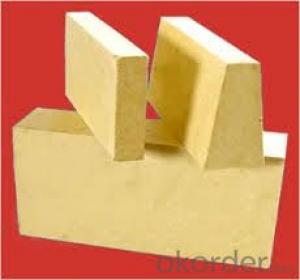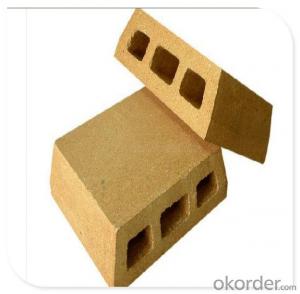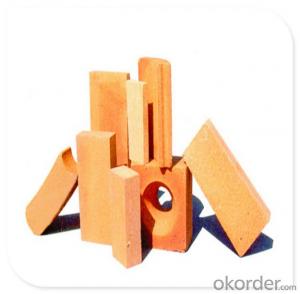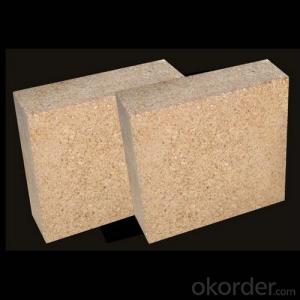High Alumina Brick for Cement Kiln Refractory
- Loading Port:
- Tianjin
- Payment Terms:
- TT OR LC
- Min Order Qty:
- 1 m.t.
- Supply Capability:
- 2000 m.t./month
OKorder Service Pledge
OKorder Financial Service
You Might Also Like
Description of Refractory Bricks
Refractory Bricks High Alumina for Cement Kiln is a kind of insulation refractory product taking refractory clay as main raw materials and including 30%~46% of AL2O3. Refractory Bricks High Alumina for Cement Kiln has a wide range of application and is mainly used in thermal equipment and insulation layer of industrial furnaces.
Specifications for Refractory Bricks
| Product Item | Refractory Bricks High Alumina for Cement Kiln | |
| KBL-65 | KBL-75 | |
| Al2O3 % | >65 | >75 |
| Fe2O3 % | 2.0 | 2.0 |
| Refractoriness °C | 1790 | 1790 |
| Apparent porosity % | 24 | 24 |
| Bulk density g/cm3 | 2.45 | 2.55 |
| Cold crushing strength Mpa | 45 | 55 |
| Refractoriness under load KD,°C | 1500 | 1520 |
| Reheating Linear Change % | 1500°C×2h (0.1~-0.2) | 1520°C×2h (0.1~-0.4) |
| Thermal shock resistance ,times (1100°C water cool) | 18 | 15 |
| Application | Industrial furnace temperature sharp parts | Industrial furnace temperature sharp parts |
Features of Refractory Bricks
Low bulk density, low thermal conductivity, good thermal insulation performance.
Refractory category allow direct contact of fire, suitable for various atmosphere.
Good integrity with furnace lining, long service life, easy operation, could be shaped freely.
Typical Application of Refractory Bricks
Furnaces of metallurgy industry, heat treatment furnace.
Furnaces of chemical industry and construction industry.
Furnace of incineration of garbage, recirculating fluidized bed furnace .



- Q: Is there a big difference between two high alumina brick and one high alumina brick?
- The difference between the two kinds of high alumina bricks is great. I perennial in Zhengzhou was responsible for the production and sale of colt refractories
- Q: Application characteristics of high alumina brick
- Refractoriness. High alumina brick products are advanced varieties of aluminium silicate refractory products, and their refractoriness increases with the increase of Al2O3 content, generally not less than 1750 - 1790 DEG C. If the content of Al2O3 is more than 95% of corundum brick, the refractoriness can be as high as 1900-2000 degrees.
- Q: What is the standard classification of high alumina bricks and high alumina bricks?
- High alumina brick is one of refractory materials. The main component of this kind of refractory brick is AL2O3. High alumina brick refractory clay brick and brick than refractoriness to high. It belongs to high refractory. High alumina brick Al2O3 more, close to the neutral refractory material, can resist acid slag and alkaline slag erosion, because it contains SiO2, so the ability of alkaline slag resistance than acid resistant slag ability is weaker.According to the number of AL2O3 content is divided into, 55,65, 75,80 and so on several grades.
- Q: What is the density of a super high alumina brick and what is the price?
- Of course, the transaction price, please choose refractory brick manufacturer is better.
- Q: How to make refractory bricks and boiler wall adhesion more firm?
- If the condition, the user heat-resistant steel welding grip nails, expansion joints can not be too big.. Also to use high temperature aluminum brick, high temperature resistance, but also to extend its use cycle.
- Q: What is the content of free silica in the refractory bricks of high alumina bricks?
- Refractory powders are not rich in free silica in varying degrees
- Q: The difference between ordinary and diatomite brick refractory brick
- To say the difference, the material is the biggest difference. There are diatomite brick density, compressive strength of small brick kiln belongs to the outer thermal insulation, and heavy refractory brick kilns for multi village in direct contact with the flame, high temperature resistance, good compressive strength, but no insulation. Hope to help you.
- Q: What is the high temperature limit of refractory bricks and refractory soil?
- According to the preparation process can be divided into bricks, brick, electric melting brick (Rong Zhuzhuan), the refractory insulating bricks; according to the shape and size can be divided into standard brick, ordinary brick, specific rotation. It can be used as high temperature building materials and structural materials for construction kilns and various thermal equipments, and can undergo various physical, chemical and mechanical changes at high temperature.
- Q: What is the difference between fireclay bricks and high alumina refractory bricks?
- High R.U.L, low creep high alumina brick [1] is using high grade bauxite, fused corundum, fused mullite as main raw material of high-grade refractory materials. The product has the advantages of high temperature, little creep, strong corrosion resistance and good thermal shock resistance, and is suitable for large and medium-sized hot blast stoves.
- Q: How can the refractory brick blast furnace be pulverized and pulverized enough not to be taken away by the wind?
- Top burning type hot blast stoveIt means that the burner is installed on the top of the hot blast furnace of the iron making equipment, and it does not need a special combustion chamber in the vault space. It is also called a non combustion chamber type hot blast stove.
Send your message to us
High Alumina Brick for Cement Kiln Refractory
- Loading Port:
- Tianjin
- Payment Terms:
- TT OR LC
- Min Order Qty:
- 1 m.t.
- Supply Capability:
- 2000 m.t./month
OKorder Service Pledge
OKorder Financial Service
Similar products
Hot products
Hot Searches
Related keywords


























